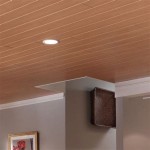How To Install Basement Ceiling Tiles In Revit
Basement ceiling tiles are a great way to finish off a basement and give it a more polished look. They are also a good way to hide unsightly wires and pipes. Installing basement ceiling tiles is a relatively easy project that can be completed in a few hours.
To install basement ceiling tiles, you will need the following materials:
- Basement ceiling tiles (most common: 2x2 or 2x4)
- Ceiling grid system
- Tile clips
- Screwdriver
- Utility knife
- Level
- Measuring tape
- Pencil
Once you have gathered your materials, you can begin the installation process.
Step 1: Prepare the Ceiling
The first step is to prepare the ceiling for the tiles. This involves removing any existing ceiling tiles or panels. You will also need to clean the ceiling and remove any dust or debris.
Step 2: Install the Ceiling Grid
The next step is to install the ceiling grid. The ceiling grid is a framework that will support the ceiling tiles. To install the ceiling grid, you will need to follow these steps:
- Determine the center of the ceiling. To do this, measure the length and width of the ceiling and divide each measurement in half. Mark the center of the ceiling with a pencil.
- Install the main runners. The main runners are the long pieces of the ceiling grid that run parallel to the walls. To install the main runners, hold a main runner against the ceiling and align it with the center mark. Screw the main runner into the ceiling joists.
- Install the cross tees. The cross tees are the shorter pieces of the ceiling grid that run perpendicular to the main runners. To install the cross tees, hold a cross tee against the ceiling and align it with the center mark. Snap the cross tee into place on the main runners.
Step 3: Install the Ceiling Tiles
Once the ceiling grid is installed, you can begin installing the ceiling tiles. To install the ceiling tiles, you will need to follow these steps:
- Place a ceiling tile on the ceiling grid. Align the tile with the grid and make sure that it is level.
- Attach the tile clips to the tile. The tile clips will hold the tile in place. To attach the tile clips, simply snap them onto the tile.
- Repeat steps 1 and 2 until all of the ceiling tiles are installed.
Step 4: Finishing Touches
Once all of the ceiling tiles are installed, you can add the finishing touches. This may include installing light fixtures, painting the ceiling, or adding molding.
Installing basement ceiling tiles is a relatively easy project that can be completed in a few hours. By following these steps, you can give your basement a more finished look and hide unsightly wires and pipes.

How To Add A Ceiling In Revit Architecture

Adding Finish Floors To Each Room Tutorial Revit Architecture

How To Add A Ceiling In Revit Architecture

6 Types Of Ceilings Modeled In Revit Tutorial Ceiling

Plastic Ceiling Panels 1282bxa Ceilings Armstrong Residential

Autodesk Revit 2024 How To Create A Ceiling

How To Create Baffle Ceiling In Revit

6 Types Of Ceilings Modeled In Revit Tutorial Ceiling

Radar Basic Acoustical Panels Medium Textured Ceiling Usg

Adding Finish Floors To Each Room Basement Revit Architecture Designing A House Tutorial Linkedin Learning Formerly Lynda Com
Related Posts








